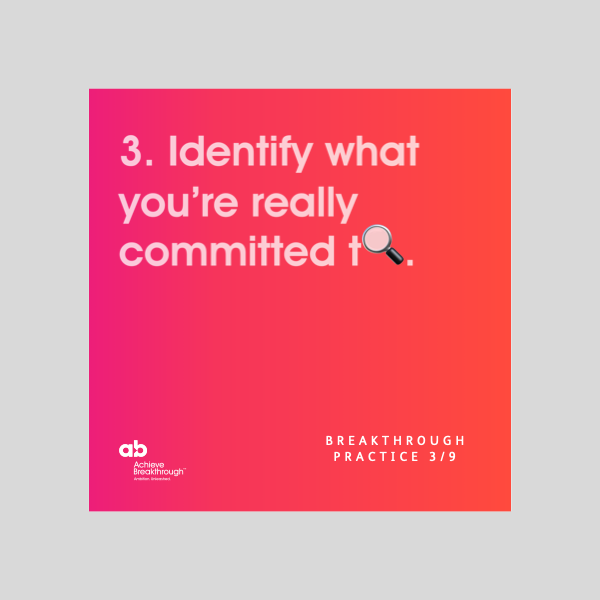Breakthrough Thinking Practice 3: Identify what you are really committed to
Leadership Blog | 4 minute read

Written by Achieve Breakthrough

---------------------------------------
Much in the same way a labourer cannot construct a building using only a hammer, leaders need a range of different practices in their toolkit in order to achieve breakthrough results.
This can sometimes mean shattering the shackles that tie us to our own human nature and shedding the behaviours that are hindering our journey towards breakthroughs. In this blog series we will unpack 9 leadership mindset and behaviour practices for you to consider adopting if you want to set yourself on hyper-speed course to achieving extraordinary, breakthrough, results.
---------------------------------------
So far in this blog series we've discussed the two breakthrough practices: 1 – “Unhooking yourself from your assessments” and 2 - “Listening for what’s missing” that will help give you more freedom when exploring what it is you really, truly want. In practice 3 we are going to zero in on what you’re really committed to.
When we’re asked what it is we want, we often tend to answer with something that is inside our existing reality. It’s still going to be something good, but only within the realms of what we think is possible.
If you ask someone who lives in a block of flats where they would like to live, they may well say they wish to move to a semi-detached property on the outskirts of town, as they feel that is better than their current situation.
If you asked someone in a semi-detached property on the outskirts of town the same question, they’ll likely say they want a larger detached property in a more desirable area. And if you ask someone in a large, detached property the same question, they might say they’d love to live in a luxury villa beside a tropical beach.
Unless they were having a purely "if I won the lottery..." sort of conversation, a person living in the block of flats is unlikely to say they want to live in a luxury villa with any conviction, since people rarely make the mental leap to think about what they really want. Instead they tend to ask for what they think it is they can get within their existing context.
Here’s the trouble: organisations think in exactly the same way.
Getting what you really want
To achieve breakthrough results, organisations first need to break out of the habit of aiming for a future that shares too many qualities with their present.
In an office that doesn’t have a coffee area, the staff may well request a coffee area to be put in place. But in reality, they’d really like a designated staff room with lockers, showers, and a canteen.
In a sales meeting, the team may agree to a 3% sales increase for next year, because they think they can just manage to achieve it with a stretch in their current efficiency.
But why work towards a 3% sales increase when you can aim for a 25% increase? Sure, it will require you to think and work in a compleltey different way, and it may be impossible in your current context. But breakthrough goals are what inspires us to go beyond our context: to get the leadership skills we need, to think beyond established processes, and to create new realities.
It’s a case of “If you could, would you?” There’s no need to aim for a standard stretch target when you can aim for a breakthrough result. NASA didn’t say “the stratosphere is high enough, we’ll just get there”, they aimed for the moon instead.
We’re not talking about goals that are so far-fetched that they’re unattainable. Pipe-dreams are a future you may well imagine but that takes zero account of the past or present. Possibilities, on the other hand, are not limited by the past or present but they do account for it. For example, running a marathon next week that you haven’t trained for would not only be risky but could also be daunting and disengaging.
When you go for a breakthrough result that speaks to your employee’s passions, skills, and sense of purpose, the rules of engagement change. And going for a breakthrough isn’t about doing more, it’s about thinking and doing differently.
Don’t let the vehicle drive for you
When setting a commitment, many people will speak about the vehicle they will use as opposed to the destination they will reach. For example, “I’m going to put a system in place that will uplift sales”, rather than simply saying, “I’m going to uplift sales by 30% and a new system is one way in which I’ll achieve that.”
Most people are hardwired to think about commitments as a plan, process, or action, rather than as an end goal. The UK education system is a prime example of a step-by-step pathway to success. We have to complete Key Stage One, and then KS2, KS3, GCSEs, and so forth. When we arrive in the business world, we’ve worked in a straight line for so long, it’s hard to think outside of a process.
So when people are new to management and leadership in our organisation, it’s rare for them to think beyond process, or aim for anything more than a stretch target.
There’s a role that senior leaders can play here, encouraging new leaders to be clear on the difference they want to make. To ask, “what’s your next impossibility?” or “What would you go for, if only you thought it were possible?”.
If new leaders double down on what matters to them, they can be unwired from process thinking. They can learn to focus instead on where they really want to go, not just the step-by-step process that will get them there. This is the kind of breakthrough thinking that enables organisations to move into new territory.
Passion brings results
Fostering a coaching culture - where you’re giving staff permission to share their personal passions - is vital to creating an environment where people will reach for impossibilities
Employees often think they simply have to sign up to an organisation’s mission and that’s all that matters. But if you can encourage employees to bring their full self to the table, you’ll get much more from them, by unlocking many innovations that will drive your mission forward.
Harnessing what every individual is passionate about – and what they’re good at – gets better results. If they dig into what they’re committed to within your organisation, the results will skyrocket, as they are working towards something they’re authentically up for.
Exceeding expectations
People want authenticity and purpose. When it’s embedded in an organisation – and when people feel free to take risks within that organisation – that authenticity and purpose translates to breakthrough business results.
A few years ago, the notion of hybrid working – working both from home and in the office – was not seen as a possibility, nor was it even asked for. But the current transition towards hybrid working, instead of a return to a pre-pandemic state, demonstrates how we can break expectations of what we thought was possible.
So when it comes to the commitments we make, we shouldn’t start with our context and think of the next logical step. To land on what we really want, we should ask ourselves, “If I was to go further, where would I want to end up?” and then, “how can I embody that future, today?” By looking beyond our vicinity, we can move beyond predictable results and begin achieving what matters most to us - both on an individual and organisational level.
So ask yourself and your people, “what’s your next impossibility?" With passion as the engine, we can go far beyond our own shores. Perhaps even to a villa beside a tropical beach.
Looking to create an impossible future? Get in touch to explore how we can help you ignite your ambitions.
Published 23/03/2022
Subscribe by Email
Achieve more breakthroughs. Get expert leadership ideas, insights and advice straight to your inbox every Saturday, as well as the occasional bit of news on us, such as offers and invitations to participate in things like events, webinars and surveys. Read. Lead. Breakthrough.
Tags
- Attracting talent
- Behaviour change
- Blended Learning
- Breakthrough Thinking
- Business partnering
- Career planning
- Change management
- Collaboration
- Communication
- Competitive strategy
- Creativity
- Decision making
- Developing middle management
- Developing millennials
- Developing talent
- Employee engagement
- Entrepreneurship
- High performing teams
- Hiring
- Human Resource Management
- Innovation
- Leadership development
- Learning technology
- Managing people
- Managing uncertainty
- Managing yourself
- Mergers & Acquisitions
- Mindset
- Motivating people
- Negotiation
- Organisational culture
- Organisational development
- Organisational values & purpose
- Performance management
- Productivity
- Programme Management
- Retaining talent
- Strategic thinking
- Strategy
- Strategy execution
- Succession planning
- Team development
- Work-life balance
Related posts
Leadership Blog
What triggers you as a leader, and how to work with it?
Achieve Breakthrough | 09/12/2025
Leadership Blog
Why it’s impossible to lead with one foot still in your old role
Achieve Breakthrough | 03/12/2025
Leadership Blog
Why a leader’s true value lies in what they enable, not just what they know
Achieve Breakthrough | 25/11/2025
Leadership Blog
Holding steady through leadership transitions
Achieve Breakthrough | 19/11/2025
